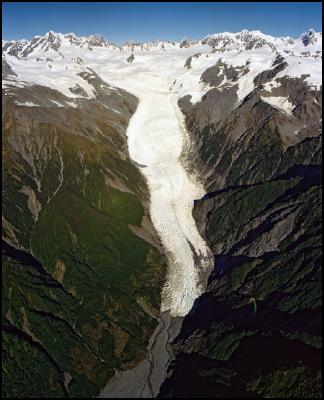New Dating Method Shows Glaciers Out Of Sync
Media Release From Gns Science,
1 May 2009
New Dating Method Shows Glaciers Out Of Sync, Scientists Find

Click for big version
Scientists have found that regional climate variations have resulted in glaciers in the Northern and Southern Hemispheres being out of step. Photo - GNS Science
Scientists
have gained new insights to global climate patterns from the
advances and retreats of glaciers in the Mount Cook region
over the past 7000 years.
Glaciers are sensitive indicators of changing climate. They become shorter when the climate warms, and lengthen when it cools.
Former positions of glaciers are marked by moraines - mounds of rock debris dumped at the front and sides of the ice tongue. The age of a moraine can tell scientists when the glacier was last at that location.
But until now, it has been difficult to reliably measure the age of a moraine.
A group of nine scientists, led by Joerg Schaefer of Lamont-Doherty Earth Observatory and including three New Zealand scientists, has successfully used an isotope dating technique to get very precise ages for moraines near Mt Cook.
Surface rocks are continually bombarded by cosmic rays. Over time, cosmic radiation causes the build-up of certain isotopes in the rock. By measuring the amounts of beryllium-10 in rocks on the moraines, the scientists have been able to pinpoint dates when glaciers in the Southern Alps started to recede.
They found, to their surprise, that the growth and retreat of New Zealand glaciers differs from glacier movements in the Northern Hemisphere. Within the past 7000 years, the Mt Cook glaciers achieved their maximum length 6500 years ago, and have been smaller ever since.
However, Swiss glaciers advanced to their maximum extent within the last 700 years - popularly known in the north as the 'Little Ice Age', which ended about 1860.
The dating reveals no simple pattern of variation. Some warm periods in Europe coincide with well-advanced glaciers in New Zealand. At other times, glaciers were well advanced in both areas.
This challenged some widely held beliefs about the global climate system and how it functions, said geologist David Barrell of GNS Science, one of the three New Zealanders involved in the project.
"The New Zealand findings point to the importance of regional shifts in wind directions and sea surface temperatures, such as El Nino - Southern Oscillation," he said.
"These regional weather patterns are superimposed on global climate trends that are reflected in the behaviour of glaciers".
The new high-precision beryllium-10 dating technique should allow for more accurate measurements of glacier behaviour worldwide.
In turn, this will provide better information that will improve the precision and usefulness of climate models.
The development is outlined in a paper in this week's issue of the journal Science.
ENDS


 Canterbury Museum: Mystery Molars Lead To Discovery Of Giant Crayfish In Ancient Aotearoa New Zealand
Canterbury Museum: Mystery Molars Lead To Discovery Of Giant Crayfish In Ancient Aotearoa New Zealand Ngā Pae o te Māramatanga: Māori Concerns About Misuse Of Facial Recognition Technology Highlighted In Science
Ngā Pae o te Māramatanga: Māori Concerns About Misuse Of Facial Recognition Technology Highlighted In Science Retail NZ: Retailers Call For Flexibility On Easter Trading Hours
Retail NZ: Retailers Call For Flexibility On Easter Trading Hours WorkSafe NZ: Worker’s Six-Metre Fall Prompts Industry Call-Out
WorkSafe NZ: Worker’s Six-Metre Fall Prompts Industry Call-Out PSGR: Has MBIE Short-Circuited Good Process In Recent Government Reforms?
PSGR: Has MBIE Short-Circuited Good Process In Recent Government Reforms? The Reserve Bank of New Zealand: RBNZ’s Five Year Funding Agreement Published
The Reserve Bank of New Zealand: RBNZ’s Five Year Funding Agreement Published



